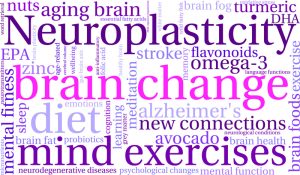Neurofeedback?
Neurofeedback is a form of biofeedback that changes the way the brain functions.
It appears to do so more effectively that medication, therapy, exercise or any other form of personal change work.
Neurofeedback is Exercise for the Brain | What the Experts Says About Neurofeedback | Most Conditions Treated with Neurofeedback
 In a very real sense, Neurofeedback is exercise for the Brain! And not just any exercise…but very specific, focused training that reshapes the way the brain functions. Neurofeedback, also called EEG Biofeedback is a state-of-the-art, non-invasive method for teaching the brain to function in a more balanced, relaxed and efficient manner. In reality, this creates a healthier brain. The EEG training does this ‘magic’ by giving the brain feedback in very rapid, precise ways.
In a very real sense, Neurofeedback is exercise for the Brain! And not just any exercise…but very specific, focused training that reshapes the way the brain functions. Neurofeedback, also called EEG Biofeedback is a state-of-the-art, non-invasive method for teaching the brain to function in a more balanced, relaxed and efficient manner. In reality, this creates a healthier brain. The EEG training does this ‘magic’ by giving the brain feedback in very rapid, precise ways.
When the brain isn’t working well, we can experience a wide range of symptoms, from anxiety, distractibility, hyperactivity, depression, brain fog, OCD or worry. Physically, we can get headaches, migraines, seizures, body tension and have sleep problems as well. Rather than talking about issues or problems, or taking medications, Neurofeedback takes a more direct approach (and does so much more effectively).
Here’s a bit of ‘geek’ talk for those of you who might be interested. Electrical impulses in the brain are broken into four major divisions; Delta, Theta, Alpha and Beta (called “Frequency Bands”). These Frequency Bands are measured in 20 locations across the head. Each band is changing continuously, but not randomly. There are clear patterns that quickly emerge, and these tell us which parts of your brain are active, how well parts are communicating together and how efficient the brain is in any particular area. These patterns correlate to various psychological and physical symptoms and point to weaknesses and strengths for each of us.
Certain patterns of these frequency bands should be active for specific activities. For instance, when we are balancing our checkbooks or in a class following directions, certain areas of our brain will need to be active and using the faster frequency called Beta. On the other hand, if after a long day we wish to relax and wind down, a different part of the brain will need to be activated using the slower brainwave frequency called Alpha. When we visualize something in our mind, another specific set of patterns emerge. These are only a few examples.
The goal of Neurofeedback is to improve the brain’s ability to self-regulate, maintain flexibility, and smoothly shift between states of relaxation, focused effort, planning, brainstorming or creating. Since your brain also controls attention, focus, creativity, awareness, attitude, emotions, memory and… well, EVERYTHING…when we bring the brain into smooth harmony with itself, the entire Central Nervous System returns to normal functioning.
Loading Video...
More on What is Neurofeedback
Simply put, neurofeedback is a form of biofeedback. But what is biofeedback? Biofeedback is a process of taking a signal imperceptible to us as humans, typically an electrical impulse, and using electronic equipment and an amplifier to amplify this signal that lies below the level of awareness for most of us. Once we are able to read the signal, we provide feedback to the person receiving the biofeedback or neurofeedback.
For example, if we want a brain wave to grow stronger, we provide a biofeedback signal every time that wave gets a bit stronger. The same process applies if we want that brain wave to be weaker.
So, in essence, biofeedback is a very organic, natural process in that nothing invasive is done to the brain or body. That’s why it has a very low risk compared to medications or almost any other form of treatment. With neurofeedback, we can only reward the brain for a state that it has already achieved. This is important to understand because we are not forcing it into any particular state. So, for example, if we have a very high theta wave, as is often the case with anxiety or ADD, we can use neurofeedback to bring theta down, often in remarkable ways.
When such an elevated brain wave fluctuates and comes down a tiny amount, the individual receiving neurofeedback gets a reward signal in the form of a reward tone or increasing brightness. There’s no real conscious effort required. As you sit and absorb the feedback, the learning occurs unconsciously, and your brain becomes more neuroplastic, more flexible, learns, expands, and grows.
We have seen this result in hundreds of studies over the past 40-45 years, to the point that neurofeedback has recently been categorized as a level four or five treatment. Level five is the highest level of treatment possible in the world of mental health, used for anxiety, depression, and many forms of ADD and ADHD. Hundreds of studies with no reported side effects have proved its remarkable effectiveness.
The bottom line is that we are giving the individual receiving neurofeedback a very precise feedback signal when that brain moves in a desirable, healthier direction. Done repeatedly over time, we can completely change the trajectory of an individual’s brain wave patterns. When these brain waves change, patterns of dysfunction, whether cognitive, emotional or behavioral, shift dramatically overtime.
“What the Experts Say About Neurofeedback”
ADHD
Disorder is actually an
aggregate of
symptoms…
Anxiety
anxiety have a
chronically hyperarousal central nervous system…
Depression
refer to as depression
is seen more as an
end stage of anxiety…
Home Train
allow you to train your brain
at home…




